Beyond the Boundary in Asia

*Pieces with no owner listed belong to the National Museum of Ethnology

-
Black Glazed Jar with Celestial Rooster
(The Osaka Museum of Oriental Ceramics Collection)

-
Porcelain Bowl with Etchings of Flowers and Lotus Petal Patterns
(The Osaka Museum of Oriental Ceramics Collection)
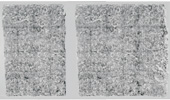
-
A Rubbing of the Gwangaeto the Great of Koguryo Stele
(National Museum of Japanese History Collection) - This is a stele that records the exploits of Gwangaeto the Great. It contains passages that mention that Paekche and Silla were originally subservient states. They also tell of military combat with Japan, and that they defeated the Japanese when they invaded in 404 A.D. These passages reveal the world-view and the nation-view of the Koguryo people.
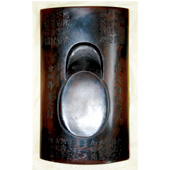
-
Tong Que Tai Tile Inkstone
(Matsumae Municipal Board of Education Collection) - This inkstone is said to have been passed to the founder of the Matsumae Clan via Sakhalin in 1485. Tong Que Tai was a building constructed by Cao Cao of Wei during the Three Kingdoms Period in China. This piece tells the tale of trade and relations via the Amur River, Sakhalin, and Hokkaido during the Muromachi Period.
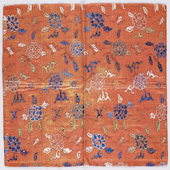
-
Ezo Brocade
(National Museum of Japanese History Collection) - “Ezo Brocade” is a Chinese-made silk textile that was brought from Matsumae Domain during the Edo Period. This piece is called the “red peony type.” The Matsumae Clan obtained it in Sakhalin from the Ainu and continental traders they called the “Sakhalinese.”
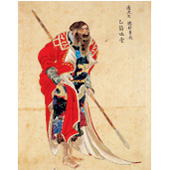
- Image of Ikotoi form the “Illustrations of Famous People from Ezo”
- This is a copy of the “Illustrations of Famous People from Ezo,” which was drawn by Kakizaki Hakyo, an elder in the Matsumae Clan. Ikotoi was the most powerful man in Akkeshi, which was then Ainu territory, and in this illustration he is depicted wearing a Russian overcoat over Ezo brocade.

-
Rubbing of a Stele from the Chronicles of the Yong Ning Si Temple
(Hakodate City Museum Collection) - This is a rubbing of a stele that describes the construction of the Yong Ning Si Temple in Nurugan territory, which is now the village of Tir, located in the lowermost reaches of the Amur River. The Ming Dynasty established a command post in Nurugan and controlled the residents of the area, such as the Ainu and the Nivks
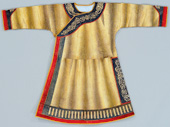
- Women’s Clothing (Made from Fishskin)
-
This is a women’s upper garment made from pieces of white salmon skin joined together and decorated with cloth. Since fish skin is highly waterproof, it was often used when going fishing, but it was also worn on special occasions.
Maritime District, Russian Federation

- Boat Made from White Birch Bark
-
This boat has a Japanese larch and spruce frame that is wrapped in white birch bark. Light and easy to carry, this boat is also sturdy and steady on the water. This boat is a large one, so it can carry up to 100kg in cargo.
Khabarovsk District, Russian Federation
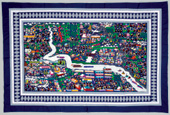
- Hmong Embroidered “Story Cloth”
-
This piece, which was embroidered by a former refugee with many colors of thread, is a history of the trials the Hmong people endured until they found a country to settle in as they passed through Laos and Thailand.
Phetchabun Province, Kingdom of Thailand

- Silver Bar Used in Betrothal Ceremonies
- This piece tells us that the idea of valuing silver as an exchangeable commodity was preserved even after migrating. This is used in Hmong and Mien betrothal ceremonies to this very day.
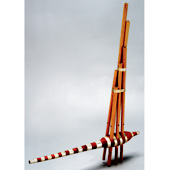
- Reed Pipe "Lusheng"
-
This instrument, which has six pipes, is an essential part of the rites of passage in China and among the Hmong of Thailand. Even after the Hmong migrated from China, this instrument is still in use, and there are performances and technical exchanges.
Wenshan County, Yunnan Province, China
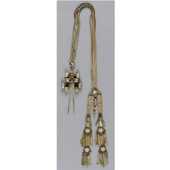
- Silver Necklace
- Chiang Rai Province, Kingdom of Thailand
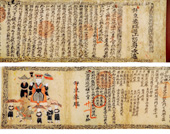
-
Ping Huang Quan Die (Document of the Mien People)
Nanzan University Anthropological Museum Collection - In 1974, a research team led by Dr. Yoshirou Shiratori of Sophia University obtained this in Ngao District, Lampang Province, Kingdom of Thailand and brought it back to Japan. The history of their ancestors, privileges regarding tax exemption and mountain residences, and presentation of official ranks are written in Chinese characters, and this piece serves as a source of identity for the Mien people.
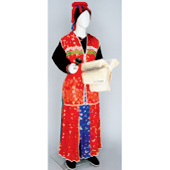
- Priest Officiating at a Ceremony
-
The Mien people adopted Daoist teachings from the Han Chinese, and their religion has strong Daoist influences. Priests hold various “merit indoctrination rituals,” such as the Kwaa-Taang ritual as well as ancestor rites and funeral ceremonies. In his hand, he holds a scripture book written in Chinese characters (private collection) and a bell.
Nan Province, Kingdom of Thailand
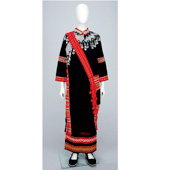
- Lahu Na Women’s Costume
-
This is called “Black Lahu.” The basic tone of the clothing is black, with silver ornaments attached to it. While the Lahu people were migrating, a subgroup called the “Lahu Ni” (Red Lahu) was formed.
Chiang Rai Province, Kingdom of Thailand









